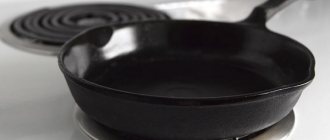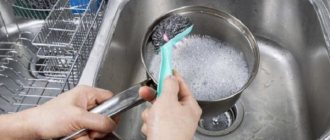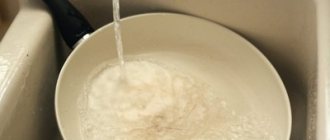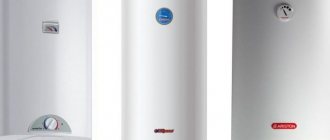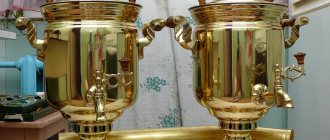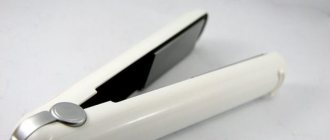Icer Can handle Teflon pans
When it came time to throw away our old cast iron skillet because it was warping, we bought a modern version with a nonstick coating. At first, cooking was a great pleasure - nothing burned and the result was excellent. But over time, deposits appeared on the walls.
To clean a Teflon pan, use a brush or sponge. No abrasive elements.
Since you can’t rub them with abrasives, I began to figure out how to clean a Teflon frying pan from carbon deposits. I read the advice of manufacturers and specialists and share the information with you.
How to clean the inside of a Teflon frying pan from carbon deposits?
Under no circumstances should the Teflon surface be cleaned with metal meshes, dish brushes, or the hard side of a sponge. A frying pan with Teflon can only be cleaned of carbon deposits inside using gentle methods. We list the most effective and safest of them.
Laundry soap
As practice shows, there is still nothing in the world that cannot be cleaned with a familiar and inexpensive piece of laundry soap. Grate ¼ of a bar of soap on a medium grater, place in a frying pan and fill with water. The soap mixture must be heated over a fire, without bringing it to a boil. Then set aside and let the soaked product stand for a couple of hours. Pour out the water and wash the bottom of the product with detergent; remaining dirt and black stains can be easily cleaned with a simple sponge.
Boiling with soda
https://www.youtube.com/watch?v=eH8bBZC8BDs
A product with a Teflon coating can be easily cleaned from carbon deposits on the inner surface by briefly boiling with soda. Dissolve 5 tbsp in 1 liter of water. soda Fill the frying pan with soda solution and place on the fire. Bring to a boil and simmer for 20 minutes. Turn off the heat and let cool. The baking soda solution will gently dissolve grease and burnt-on food particles, making it incredibly easy to clean the frying pan after baking soda. Pour out the cooled solution and rinse the surface of the Teflon coating with a soft sponge.
Silicate glue
If you need to clean a Teflon-coated product from heavy carbon deposits, then this method is for you. You will need 1-2 tubes of silicate glue, 100 g of dishwashing detergent (Myth, Biolan, etc.), 1 tbsp. soda ash (sold in household supplies), 2 liters of water. Mix all ingredients. Pour this mixture into the problem pan and boil for an hour.
For modern Teflon cookware, you can purchase special chemicals. They can easily clean the bottom of the frying pan from black stains and old fat. Remember that household chemicals are not safe for use on surfaces that come into contact with food - caustic substances “eat” Teflon. The outside of the kitchen product can be treated without fear using any of the following means.
Gels and creams
Gels are highly concentrated products; it is enough to apply them to the surface with carbon deposits and leave for half an hour to an hour, then clean off the remaining carbon deposits with a sponge, and rinse the product itself thoroughly. Sanita, Domestos cream, Antinagar gel will cope with the task.
With the spray, you don't need to make any effort to clean the carbon deposits. For example, Mister Muscle (for the kitchen), Fairy Power, Kiilto with nanosilver, etc. You need to spray the outer bottom and walls of the frying pan with the solution several times, leave for a couple of minutes, and rinse with water. The soot is gone!
Foam against carbon deposits
The active substances in the foam dissolve carbon deposits in a matter of minutes. The concentrated foaming agent Amway Dish Drops does a good job of removing carbon deposits. Dilute a small amount of liquid with water according to the instructions and beat into foam. Apply the foam evenly to the outer bottom and leave for 15 minutes. All that remains is to clean off any remaining grease and dirt under running water with a foam sponge. You should clean the frying pan without pressing, but do not forget to foam the walls and the surface under the handle in addition to the bottom.
Liquid products
Liquid products for removing carbon deposits from external surfaces, such as Milam and Shumanit, have proven themselves well. Cleaning a kitchen product in this way is quite easy, but you should definitely do it with gloves. Apply the product to the problematic surface and clean the bottom with a damp sponge. Leave on for 15 minutes, then rinse with water and rinse twice.
The fumes on the inside of the pan are washed off first, since this part interacts with food. The selected substance should not be harmful to health, so cleaning is carried out only with folk remedies.
Mustard powder will quickly and safely remove a small layer of burning and grease. The powder is poured onto a soft sponge, after moistening it in water, and the dirt is wiped off. Then the frying pan is washed in warm water with baby soap.
Laundry soap
You can find laundry soap in every home. This simple remedy will help you effectively get rid of carbon deposits.
Cleaning process:
- Grate 1/4 of a bar of soap.
- The mass is placed in a frying pan and filled with water.
- Place on low heat and heat without bringing to a boil.
- The frying pan along with the soap solution is left to cool.
Be sure to read:
How to clean the oven quickly and effectively in 5 minutes: the best ways
After 2 hours, the solution is drained. The dishes are washed thoroughly using a simple detergent and a soft sponge.
Boiling with soda
Soda is the best helper in the kitchen.
It easily breaks down fat deposits, and the dishes acquire their original shine:
- Dissolve 5 tsp in a 1 liter container. soda
- The soda solution is poured into a frying pan and boiled for 20 minutes.
- Remains of burnt food are removed with a soft sponge after the mixture has cooled.
Baking soda mixed with detergent breaks down fats 2 times faster.
To clean the Teflon surface you only need baking soda and water
Mode of application:
- Add 1 tbsp to the water. l. baking soda and a few drops of detergent, mix everything.
- The solution is poured into a frying pan, put on fire and brought to a boil.
- Remove from heat and leave to cool.
- After 50 minutes, the solution is drained and the pan is thoroughly washed.
To ensure that the cleaning agent is completely washed off, pour plain water into the frying pan, put it on the fire and boil for several minutes.
The appearance of the dishes will be completely restored if you clean them with soda and the addition of office glue. The glue does not have any effect on the non-stick coating and human health.
To prepare the solution you will need:
- soda – 1/3 pack;
- office glue - 1 tube.
Fill the frying pan halfway with water, add the prepared solution and boil for 45 minutes. Then leave to cool for 3 hours and wash off. If the mixture is left for a day, the effect will be better.
Toothpaste
Tooth powder and toothpaste can be used to easily clean burnt-on food on aluminum pans. A small amount of powder is poured onto the burnt bottom and left for 12 hours.
Tooth powder and toothpaste can be used to easily clean burnt-on food on aluminum pans
Then the product is wiped with a rag and washed under water. If necessary, repeat the procedure.
Ethanol
Treating the pan with ethyl alcohol will help remove baked-on greasy stains. Rub the inside of the product with alcohol and leave for an hour. When the fat is peeled off, the product is washed.
Coca Cola
Coca-Cola effectively removes old scale and plaque formed on dishes. Fill the container with Coca-Cola and boil. Then rinse under water.
Be sure to read:
How to clean a burnt stainless steel pan: effective methods and means
If you regularly take preventive measures against the formation of fat deposits and soot, the need for cleaning will decrease.
Care instructions:
- The pan is washed every time after use.
- Spoons, spatulas and other accessories made of metal cannot be used.
- Excessive overheating will deform the pan, so overheating should not be allowed above 250 °C.
- Once a week, the outside of the product is washed with a chemical detergent.
Conclusion
The service life of the dishes will be long, and their original cleanliness and shine will remain at the desired level if you follow all the recommendations for removing grease.
In order not to harm your health, all damaged kitchen utensils must be promptly replaced with new ones.
We suggest you read: How to clean a shower head from limescale and scale inside and outside
So, you need to solve a more difficult problem - how to clean a non-stick frying pan from the inside and outside. Removing contaminants from the outside can be much more difficult. One effective method is to use baking soda and vinegar. Rub - outside! – baking soda in a frying pan and pour plenty of vinegar over it. After the hissing finishes, rinse with a sponge under high water pressure.
It is important not to use detergents on the inner surface so that the chemicals do not penetrate into the food and then into the human body.
You can also try mechanical cleaning using a stiff brush mounted on a drill.
But the incandescent method is absolutely not suitable; frying pans with a non-stick coating cannot be heated empty, this leads to deformation of both the frying pan and the coating.
Any cookware with a non-stick coating cannot withstand harsh cleaning and cleaning powders.
You can also use natural coffee grounds as a scrub to clean small stains on the outside of the frying pan. It cleans perfectly - but only from the outside, remember about its abrasive properties and do not use it to clean the coating.
There is no need to scrub with force, even with a soft sponge, to try to remove the grease.
Note! Old and small stains can also be removed by boiling the dishes in regular Coca-Cola. This drink has already been repeatedly noted for its cleaning properties - and it copes with frying pans as easily as with coins and rust.
How to clean a Tefal frying pan from carbon deposits or from other non-stick coatings from fat is a more difficult task. Most often, at home, it is solved in this way - grated laundry soap, soda ash and silicate glue are combined in a large saucepan. The contaminated dishes are lowered, placed on the fire, and brought to a boil.
It is necessary to turn on the hood at full power, or open a window for ventilation.
One popular method is a mixture of ammonia and boric acid. But here you should take into account, firstly, the type of coating - not all of them tolerate acid, and secondly, the duration of exposure. Even for the strongest Teflon, prolonged contact with acid is not recommended.
You can try cleaning old stains with toothpaste. It should be applied to the surface, smeared with a soft brush, left for about half an hour, and rinsed off with a soft sponge under water pressure.
We wash away soot from the outside
External walls can be cleaned using traditional methods and special professional chemicals.
Lemon acid . Boil three liters of water and add a tablespoon of powder to it. Pour the solution into a large bowl and place the frying pan in it. After two hours, remove the utensils and rinse them with warm water. Remaining carbon deposits and grease can be removed using a soft sponge and dishwashing detergent.
Peroxide and baking soda . Mix together five tablespoons of hydrogen peroxide and three tablespoons of sodium bicarbonate in a ceramic bowl. Using a washcloth, apply the prepared paste to the outer walls and wipe off the carbon deposits. After cleaning, rinse the pan thoroughly with water and wipe dry with a soft cloth.
Soda and laundry soap . Thanks to these components, you can not only wash dishes, but also disinfect them. Take a large basin and pour eight liters of water into it. Grind two bars of soap and add two packs of soda to it. Mix everything thoroughly and pour into water. Make sure the mixture is well dissolved. After this, lower the frying pan into the basin and simmer it over low heat for about an hour. After that, take it out, wait until it cools down a little, and wash off the remaining carbon deposits with a foam sponge.
Professional chemistry . The following substances can be used for cleaning:
- in the form of a spray: a special anti-carbon spray is suitable for this, for example, Mister Muscle, Kiilto, Fairy Power. Apply the product to the desired surface for a few minutes, and then rinse it off with warm running water.
- on a gel or cream basis: you can use the following cleaning agents: Domestos, Sanita, Antinagar. Put gloves on your hands, apply detergent to a washcloth and lubricate the bottom and walls well. After half an hour, the remaining substance should be washed off with plenty of water.
- in the form of foam: the active substances in the product remove carbon deposits and grease in a matter of minutes. It is best to use Amway Dish Drops detergent. This is an expensive drug, but effective and efficient. Treat the outer walls of the dish and leave it for fifteen minutes. After the time has passed, rinse the substance under running water. Do not forget that it is best to wear gloves when working with professional chemicals.
Use chemicals only to clean the exterior surface.
If it comes into contact with the Teflon coating, aggressive chemicals can damage it and the product will be damaged. Remember also that the drugs must be washed off thoroughly, otherwise if they enter the human body they can cause poisoning and various diseases.
What features does non-stick coating have?
The non-stick coating makes the bottom and walls of the cookware thicker, which improves their heat transfer and allows you to spend less energy on cooking. In addition, when preparing food, you can use a minimum of oil or fat, which allows you to preserve vitamins and nutrients in the food.
Pans with such a coating last longer, are easier to cook with, and are not demanding to maintain.
One of the leaders in the market for such tableware since 1956 is the Tefal company. One of the patented inventions is the famous Spot Point - a red circle in the center of the frying pan. It shows the optimal heating temperature of the frying pan, becoming a solid bright red color.
Teflon is a chemical available in powder or aqueous solution form.
When dishes are actively used, they cannot escape contamination. Residues of oil after frying, dough, drops of jam, etc. - every housewife is familiar with this list. Despite the fact that cooking in such a frying pan requires a minimum of fat or oil, it should still be cleaned after each use. And then the question arises for every housewife - how to clean a frying pan with a non-stick coating?
The Teflon coating is easy to scratch, so do not use acids or alkalis.
Important! The non-stick coating is specially designed for ease of care and cooking; resistance to dirt is one of the main qualities. If you notice that the frying pan has become more susceptible to contamination inside, or that it has become more difficult to clean, be sure to take a closer look at the coating applied. Most likely it is damaged. In this case, the frying pan is not recommended for use, especially Teflon. Unfortunately, it needs to be replaced.
Many housewives choose non-stick cookware because they are effective in the cooking process. Contrary to popular belief, caring for them is convenient and simple. The main thing is to promptly rinse from food and oil residues.
Coverage features:
- The heating is uniform due to the thick walls and bottom;
- Easy to care for - just wash immediately after cooking with a soft sponge;
- You don't need to use a lot of fat - nothing will burn in the pan.
The service life will increase significantly if you use wooden or silicone spatulas.
The service life will increase significantly if you use wooden or silicone spatulas - they do not scratch the surface. Any damage that disrupts the coating layer leads to sticking of the products.
Thus, the advantages of a Teflon frying pan over a regular one are obvious.
The non-stick coating continues to properly perform its main function only if there is no damage. It is important that it lasts as long as possible so that you don’t have to get rid of the pan. There are several inappropriate means and methods:
- Citric acid, soda powder, undiluted vinegar, household chemicals with acids and alkalis. Exposure to aggressive chemicals will quickly damage the coating, corroding it along with contaminants.
- Powders and abrasives - they scratch the surface even when washed with a soft sponge.
- The hard side of the sponges, metal brushes and meshes will leave scratches.
- Strong and uneven heating will damage the coating. This is why salt cannot be found among home methods: it gets very hot and can also scratch the surface.
It is important not to use detergents on the inner surface so that the chemicals do not penetrate into the food and then into the human body.
It is important to use silicone or wooden spatulas when cooking.
Do not wash the frying pan or place it in a sink with water immediately after cooking. It is necessary to let it cool on the stove after removing the food. Forced cooling will cause the coating to begin to peel off. Be sure to wash in warm water using a soft sponge.
It is recommended to wash dishes on the same day you cook in them. It is worth leaving for 1-2 days, and then just rinse, as fat begins to form. While removing thick layers of dirt, you can inadvertently begin to wash off the base coating.
Soot always causes food to stick and burn. You may think that everything has been successfully washed, but the best test is cooking. You should also wet the surface frequently to remove food debris.
Non-stick pans are dishwasher safe.
Non-stick pans are dishwasher safe. However, the equipment cannot cope with severe contamination and old grease - it must be cleaned manually. But with frequent use and constant washing, the frying pan will last quite a long time.
Timely washing will extend the life of the coating. In old cases, you will have to turn to home remedies to cleanse the grease. All methods, when used correctly and in a controlled manner, are absolutely safe for coating.
Methods for cleaning a non-stick frying pan
Methods for cleaning a non-stick frying pan inside and outside should be equally delicate. There is no need to buy expensive detergents that are supposedly suitable for washing - they still contain chemicals. You should make a choice in favor of more gentle folk methods.
It is recommended to choose a cleaning method based on the type of coating. There are four varieties in total:
- Teflon (easy to scratch);
Teflon coated frying pan.
- Enamel (scratches and chips appear);
Frying pan with enamel coating.
- Ceramics (the coating often chips);
Frying pan with ceramic coating.
However, they are all based on Teflon - this polymer is heat-resistant and environmentally friendly.
Additional Information. A frying pan with a Teflon non-stick coating was first released in 1956 in France. The developer was Tefal.
We suggest you read: How to remove wax from clothes
